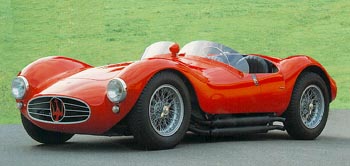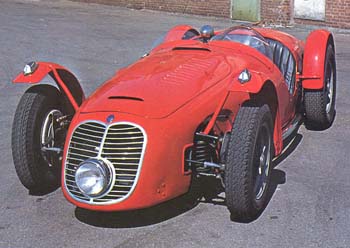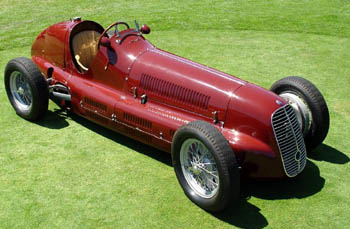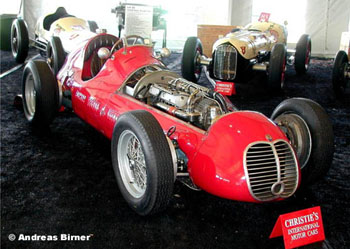
Model
4CLT/48
Produced
1948-1950
Number of cars built
18
Engine
Engine type
in-line 4
Bore/stroke
78x78 mm
Displacement
1,490.8 cc
Position
front
Compression ratio
6:1
Maximum power output
260 bhp at 7,000 rpm
Valve timing
four valves per cylinder set in a 90°V, twin overhead camshafts
Fuel feed
two Roots superchargers, a single Weber 50 DCO (52 DCO) carburettor mounted ahead of the superchargers
Ignition
single-plug, Marelli ST24DAS magneto
Lubrication
dual oil pumps (pressure and scavenge)
Transmission
Clutch
dry, multi-plate
Gearbox
4-speed + reverse
Chassis
Bodywork
aluminium-bodied single seater
Chassis
tubular with two main side members and cross members
Front suspension
helical springs, hydraulic Houdaille dampers and anti-roll bar
Rear suspension
helical springs, hydraulic Houdaille dampers and anti-roll bar
Brakes
hydraulic drum brakes on the wheels
Steering
worm gear
Cooling system
water-cooled, centrifugal pump
Dimensions
Length
151.57 in. (3,850 mm)
Width
55.12 in (1,400 mm)
Height
39.37 in. (1,000 mm)
Wheelbase
98.42 in. (2,500 mm)
Front/rear track
49.21/47.24 in. (1,250/1,200 mm)
Wheels
wire wheels, 3.25x17 - 4.00x16
Tyres
front 5.25x17-5.00x17; rear 6.00x16-6.50x16; Pirelli, Englebert, Dunlop
Dry weight
1,389 lbs (630 kg)
Fuel tank
26.40 Imp. gall. (120 litres)
Performance
Maximum speed
161.5-168 mph (260-270 km/h)
Notes
two examples of the 4CLT/50 were built in 1950 with 1,720.2 cc engines (bore/stroke78x90 mm)
-----------------------------------------------------------------------------------------------------------------------------

Model
8CLT
Produced
1950
Number of cars built
2
Engine
Engine type
in-line 8
Bore/stroke
78x78 mm
Displacement
2,981.7 cc
Position
front
Compression ratio
6.5:1
Maximum power output
430 bhp at 6,500 rpm
Valve timing
four valves per cylinder set in a 90°V, twin overhead camshafts
Fuel feed
two Roots superchargers, a single Weber 52 DCO carburettor mounted ahead of the superchargers
Ignition
single-plug, Marelli magneto
Lubrication
dual oil pumps (pressure and scavenge)
Transmission
Clutch
dry, multi-plate
Gearbox
4-speed + reverse
Chassis
Bodywork
aluminium-bodied single seater
Chassis
tubular with two main side members and cross members
Front suspension
helical springs, hydraulic Houdaille dampers
Rear suspension
helical springs, hydraulic Houdaille dampers
Brakes
hydraulic drum brakes on the wheels
Steering
worm and sector
Cooling system
water-cooled, centrifugal pump
Dimensions
Length
151.57 in. (3,850 mm)
Width
55.12 in (1,400 mm)
Height
39.37 in. (1,000 mm)
Wheelbase
107.08 in. (2,720 mm)
Front/rear track
54.72/53.34 in. (1,390/1,355 mm)
Wheels
wire wheels, 3.50x19-5.00x20
Tyres
front 5.50x19; rear 7.00x20; Pirelli
Dry weight
1,763 lbs (800 kg)
Fuel tank
26.40 Imp. gall. (120 litres)
Performance
Maximum speed
199 mph (320 km/h)
-----------------------------------------------------------------------------------------------------------------------------

Model
A6GCM
Produced
1951-1953
Number of cars built
12 (5 transformed into 250Fs by changing the engine)
Engine
Engine type
in-line 6
Bore/stroke
72.6x80 mm (1951-52); 75x75 mm (1952); 76.2x72 mm (1953)
Displacement
1,987 cc (1951-52); 1,988.1 cc (1952); 1,959.5 cc (1953)
Position
front
Compression ratio
13.5:1 (1951-52); 12:1 (1953)
Maximum power output
160 bhp at 6,500 rpm (1951-52); 180 bhp at 7,300 rpm (1952); 197 bhp at 8,000 rpm (1953)
Valve timing
two valves per cylinder, twin overhead camshafts
Fuel feed
naturally aspirated, three Weber 38 DCO3 (40 DCO3) carburettors
Ignition
single-plug, Marelli ST25DAS magneto (1951-52) - twin-plug, two Marelli magnetos (1952-53)
Lubrication
dual oil pumps (pressure and scavenge)
Transmission
Clutch
dry, multi-plate
Gearbox
4-speed + reverse
Chassis
Bodywork
aluminium-bodied single seater
Chassis
tubular with two main side members and cross members
Front suspension
helical springs, hydraulic Houdaille dampers and anti-roll bar
Rear suspension
helical springs, hydraulic Houdaille dampers and anti-roll bar
Brakes
hydraulic drum brakes on the wheels
Steering
worm gear
Cooling system
water-cooled, centrifugal pump
Dimensions
Length
141.73 in. (3,600 mm)
Width
59.05 in. (1,500 mm)
Height
39.37 in. (1,000 mm)
Wheelbase
1951-52 - 89.76 in. (2,280 mm); 1953 - 90.94 in. (2,310 mm)
Front/rear track
1951-52 - 50.31/47.24 in. (1,278/1,200 mm); 1953 - 48.23/45.67 in. (1,225/1,160 mm)
Wheels
wire wheels, 4.00x15 (1951-52); 5.00x16 (1953)
Tyres
front 5.00x15-5.50x15 (1951-52); 5.25x16 (1953); rear 6.00x15-6.50x15 (1951-52); 6.50x16 (1953); Pirelli
Dry weight
1951-52: 1,212-1,234 lbs (550-560 kg); 1953: 1,256 lbs (570 kg)
Fuel tank
44 Imp. gall. (200 litres)
Performance
Maximum speed
155 mph (250 km/h)
-----------------------------------------------------------------------------------------------------------------------------

Model
250F
Produced
1954-1958
Number of cars built
26
Engine
Engine type
in-line 6
Bore/stroke
84x75 mm
Displacement
2,493.8 cc
Position
front
Compression ratio
12:1 (10.8:1 in 1958)
Maximum power output
240-270 bhp at 7,200-8,000 rpm
Valve timing
two valves per cylinder, twin overhead camshafts
Fuel feed
naturally aspirated, three Weber 42 DCO3-45 DCO3 carburettors (also indirect and direct fuel injection in 1956)
Ignition
twin-plug, two Marelli magnetos
Lubrication
dual oil pumps (pressure and scavenge)
Transmission
Clutch
dry, multi-plate
Gearbox
4-speed + reverse in unit with differential
Chassis
Bodywork
aluminium-bodied single seater
Chassis
tubular space-frame (from 1957)
Front suspension
helical springs, hydraulic Houdaille dampers and anti-roll bar
Rear suspension
de Dion rear axle, transverse leaf spring, hydraulic Houdaille dampers and anti-roll bar
Brakes
hydraulic drum brakes on the wheels
Steering
worm gear
Cooling system
water-cooled, centrifugal pump
Dimensions
Length
159.45 in. (4,050 mm); from 1957 168.11 in. (4,270 mm)
Width
38.58 in. (980 mm); from 1957 35.82 in. (910 mm)
Height
37.40 in. (950 mm); from 1957 35.43 in. (900 mm)
Wheelbase
89.76 in. (2,280 mm); from 1957 87.60 in. (2,225 mm)
Front/rear track
51.18/49.21 in. (1,300/1,250 mm)
Wheels
wire wheels, front 4.00x15, rear 5.50x16-6.00x17
Tyres
front 5.25x16-5.50x16-6.50x16; rear 6.50x16-7.00x16-7.00x17; Pirelli
Dry weight
1,477-1,389 lbs (670-630 kg); 1958 1,212 lbs (550 kg)
Fuel tank
44 Imp. gall. (200 litres)
Performance
Maximum speed
180 mph (290 km/h)
Notes
5-speed gearbox from 1955; wheelbase shortened to 2,200 mm in 1958 with front track of 1,310 mm
------------------------------------------------------------------------------------------------------------------------------

Model
250F T2
Produced
1957
Number of cars built
2
Engine
Engine type
60° V12
Bore/stroke
68.7x56 mm
Displacement
2,490.9 cc
Position
front
Compression ratio
11.3:1
Maximum power output
310 bhp at 10,000 rpm
Valve timing
two valves per cylinder, twin overhead camshafts per cylinder bank
Fuel feed
naturally aspirated, six Weber 35IDM carburettors
Ignition
twin-plug, two special Marelli distributors with 24 coils
Lubrication
dual oil pumps (pressure and scavenge)
Transmission
Clutch
dry, multi-plate
Gearbox
5-speed + reverse in unit with differential
Chassis
Bodywork
aluminium-bodied single seater
Chassis
tubular space-frame
Front suspension
helical springs, hydraulic Houdaille dampers and anti-roll bar
Rear suspension
de Dion rear axle, transverse leaf spring, hydraulic Houdaille dampers and anti-roll bar
Brakes
hydraulic drum brakes on the wheels
Steering
worm gear
Cooling system
water-cooled, two centrifugal pumps
Dimensions
Length
171.26 in. (4,350 mm)
Width
35.43 in. (900 mm)
Height
35.43 in. (900 mm)
Wheelbase
90.55 in. (2,300 mm)
Front/rear track
51.57/49.21 in. (1,310/1,250 mm)
Wheels
wire wheels, front 4.00x16-4.00x17; rear 5.50x16-6.00x17
Tyres
front 5.50x16-6.50x16-5.50x17; rear 7.00x16-7.00x17; Pirelli
Dry weight
1,433 lbs (650 kg)
Fuel tank
50.59 Imp. gall. (230 litres)
Performance
Maximum speed
189 mph (305 km/h)
-----------------------------------------------------------------------------------------------------------------------------

Model
420/M/58 Eldorado
Produced
1958-1959
Number of cars built
1
Engine
Engine type
90° V8
Bore/stroke
93.8x75.8 mm
Displacement
4,190.4 cc
Position
front
Compression ratio
12:1
Maximum power output
410 bhp at 8,000 rpm
Valve timing
two valves per cylinder, twin overhead camshafts per cylinder bank
Fuel feed
naturally aspirated, four Weber 46 IDM carburettors
Ignition
twin-plug, Marelli magnetos
Lubrication
dual oil pumps (pressure and scavenge)
Transmission
Clutch
dry, multi-plate
Gearbox
2-speed + reverse on rear axle
Chassis
Bodywork
Formula Indy aluminium-bodied single seater
Chassis
tubular space-frame
Front suspension
helical springs, hydraulic dampers
Rear suspension
de Dion rear axle, transverse leaf spring, twin hydraulic dampers
Brakes
hydraulic drum brakes
Steering
worm and sector
Cooling system
water-cooled, centrifugal pump
Dimensions
Length
188.97 in. (4,800 mm)
Width
47.24 in. (1,200 mm)
Height
43.30 in. (1,100 mm)
Wheelbase
94.49 in. (2,400 mm)
Front/rear track
51.18/49.21 in. (1,300/1,250 mm)
Wheels
Halibrand steel wheels
Tyres
front 7.60x16-8.00x16; rear 8.00x18; Firestone
Dry weight
1,671 lbs (758 kg)
Fuel tank
55 Imp. gall. (250 litres)
Performance
Maximum speed
217 mph (350 km/h)
Notes
known as 420M/59 in 1959






























